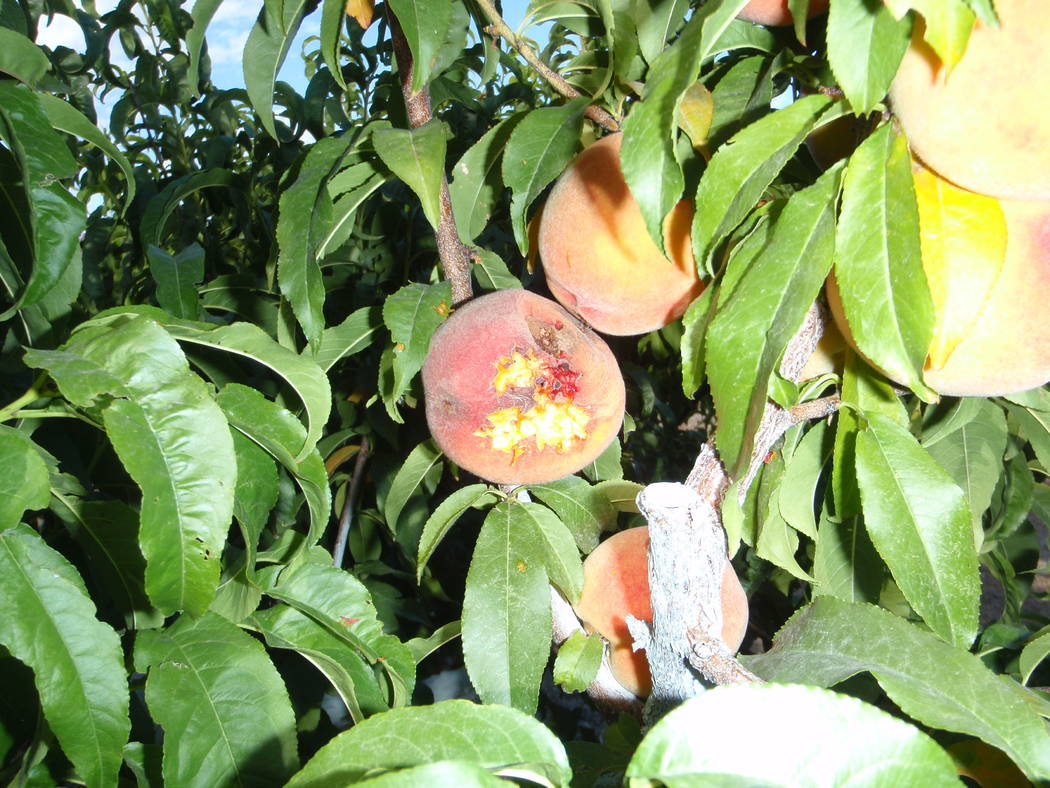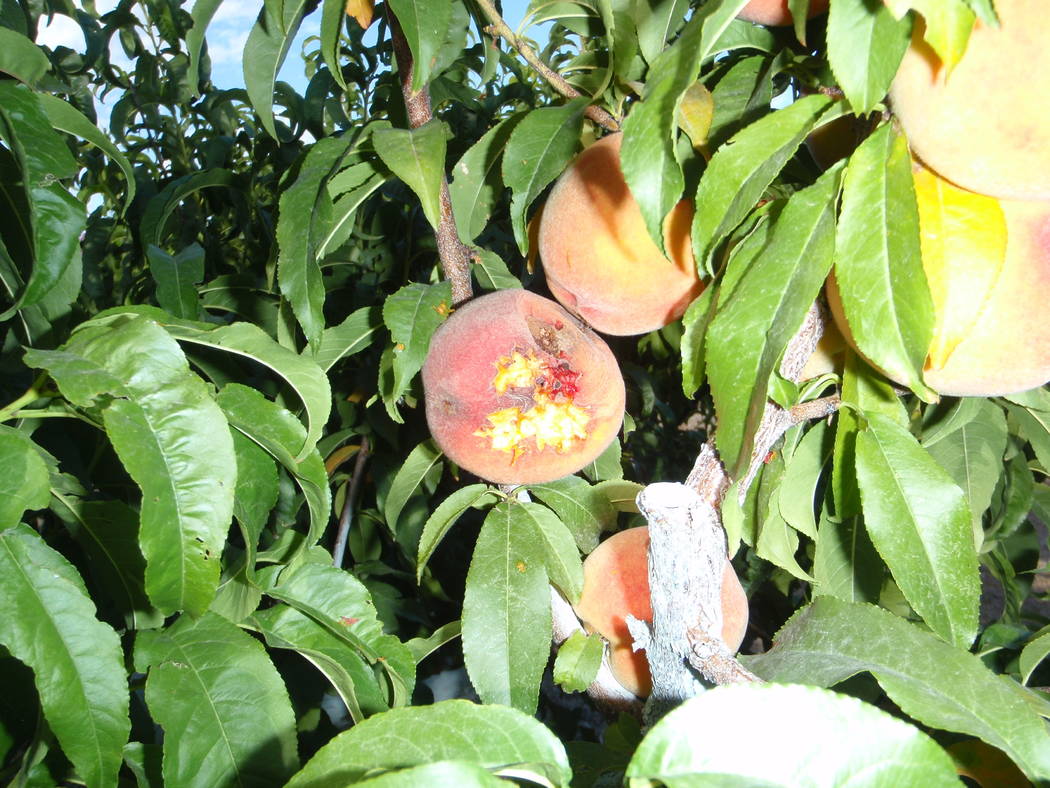Some types of fruit perform better in desert than others
Q: This past year we had lots of fruit, but the problem seems to be the same every year; when do you know its ripe? We pick one fruit every couple of days when they are looking good and try it, but they are sour and hard. Then they slowly start wrinkling and falling off at some point.
A: You didn’t mention the type of fruit or the variety, but some types of fruit and varieties perform better than others in the desert. Make sure the type of fruit and variety has a history of good performance in the desert. If it’s a bad performer, it doesn’t get any better when it gets older.
Fruit is ready to pick on nearly the same calendar day from year to year. There may be some slight variations but, generally, varieties of fruit will be ready within a few days of each other from year to year. Ask your nursery when or contact me if you aren’t sure, but we need to know the variety to tell you when it should be ready for picking.
Having enough water available to the tree is important when the fruit is getting bigger. If there is not enough water, the fruit will enlarge to a point, never mature and then fall off the tree.
Knowing when to pick comes from experience. Using a change in color is usually a good indicator. However, fruit will change color as it is maturing, but this change in color may not mean it is ready to eat.
Many fruits, such as peaches, apricots, nectarines and plums, continue to develop in flavor and softness after they are picked. Pick the fruit and leave it on the kitchen counter at room temperature for a few days before eating.
Sometimes a good indicator is bird damage to the fruit. They get interested in the fruit as it gets closer to harvest. They are interested in the same thing you are: sweetness, flavor and aroma. If you see bird damage to the fruit, start picking it.
Q: I have carpet roses growing which I originally saw blooming beautifully in the parking lot areas in central California. Can you tell me about pruning and their recommended care including fertilizing?
A: Carpet roses were developed and introduced for use in mass planting as a groundcover, more of a utilitarian rose, compared to individually planted shrub roses. The standard shrub roses, like hybrid teas and Grandiflora, are more sophisticated in appearance, color, fragrance and beauty. They are meant to stand alone and command attention individually.
The appeal of carpet roses is for mass plantings of color while providing relative ease of maintenance. They do not have the same level of sophistication as shrub roses and their level of care is less. Flower color varies from white and yellow to red, pinks and oranges.
Carpet roses may be easier to care for but still have the same requirements as shrub roses when grown in desert soil. Avoid intense heat and sunlight, prepare the soil at planting with good compost, ensure sufficient water drainage, apply wood chip mulch on the soil surface and not rock mulch, regular fertilizer applications and annual winter pruning.
Carpet roses are pruned with sharp hedge shears to about one-third of their size in late winter. Hedging, along with fertilizer and irrigation, causes a profusion of new growth and flowering. The best flowering is during the cooler spring and fall months.
Q: I have a three-in-one pluot tree (Flavor Queen, Dapple Dandy and Flavor Supreme) that I purchased five years ago from the master gardener university orchard. The canopy is about 6 feet in diameter now. It has yielded fruit for four years. I had only one or two years of good fruit from the Flavor Supreme. I’m about ready to remove it if it doesn’t get better.
A: Flavor Supreme pluot produces fruit erratically from year to year because of how sensitive it is to late spring freezing weather. Dapple Dandy and Flavor Queen pluots sail through light freezes and produce fruit more consistently year to year. But when it does produce, Flavor Supreme is one of the best-tasting fruits in the garden.
Make sure the tree is getting enough water. All fruit needs plenty of water when the fruit is increasing in size. If you short the tree on water when the fruit is getting bigger, the fruit will be small. If water is in short supply, the fruit may dry up and fall from the tree.
Make sure the tree is getting enough water each time it is irrigated. Avoid watering daily. Add drip emitters to increase the amount of water applied. Make sure drip emitters are not plugged.
Five-gallon trees getting enough water should be at least 5 to 6 feet tall by their second year in the ground. If they aren’t, increase the amount of water they are receiving, apply wood chip mulch under the tree canopy and fertilize at least every year in January or early February.
Q: When using wood chip mulch or compost on top of desert soil, do you apply mineral fertilizer to the top of the mulch or move the mulch to the side and apply it to the soil? If you don’t, wouldn’t the fertilizer just lay on top of the mulch?
A: Let’s back up a little bit and then I’ll answer your question. Wood chip mulch and compost are not used for the same purposes. Wood chip mulch is applied to the soil surface to slowly improve the soil over time, suppress weeds, slow water loss from the soil and keep the soil cool. But wood chip mulch, applied by itself, does not encourage strong plant growth.
Compost, on the other hand, also improves the soil but — if it’s a good compost — encourages strong plant growth as well. If good compost is applied to the soil surface, a fertilizer application is seldom needed that year. Adding fertilizer, together with good compost, would be redundant.
Wood chip mulch, if applied to the soil surface by itself, slowly “dissolves” into the soil, or breaks down, if water is present. This breakdown of wood chips mulch begins improving soil the first year after its application.
Applying compost with wood chips causes wood chips to decompose or break down more quickly — but so can the right fertilizer.
Fertilizers high in nitrogen, the first of the three numbers on the bag, cause wood chip mulch to decompose quickly as well. This is because the nitrogen in compost and the nitrogen in fertilizer both cause wood chip mulch to decompose faster than it would if it were applied alone.
Now, your question. It is best to rake wood chip mulch to the side and apply compost or fertilizer directly to the soil where it becomes wet. However, if the mulch is coarse, compost or fertilizer can be washed into the mulch with a hose. The mixture of compost or high nitrogen fertilizers, together with wood chips, slowly releases a variety of nutrients to plant roots.
Apply compost with wood chips or fertilizer with wood chips but don’t apply compost together with fertilizer. The two together causes excessive plant growth.
Q: I have a large Mondell pine which I didn’t realize wasn’t getting enough water last summer. I started watering it more and even though the needles were sparse, it still had some green branches. What can I do to it this year other than more watering? Is there something I should be feeding it?
A: There isn’t much more you can do at this point. It may have damage that is not reversible. The dead parts will need to be removed. If too much dies and it no longer looks good or is a safety concern, you might need to have it removed.
Water is most critical. Increase the amount of water at each irrigation. Apply this water to an area equal to at least half the diameter of the canopy and to a depth of at least two feet. Water can be contained at the base of the tree by using a basin surrounding the trunk or through drip emitters spaced about 2 feet apart.
If the tree starts to recover to your satisfaction, apply a fertilizer to the soil where water is applied. Use a lawn or tree and shrub type fertilizer. It is best applied in the spring but if you see the tree recovering, then apply it during any month you see its recovery. After the first year of recovery, apply it in early spring from that point forward.
Bob Morris is a horticulture expert and professor emeritus of the University of Nevada, Las Vegas. Visit his blog at xtremehorticulture.blogspot.com. Send questions to Extremehort@aol.com.



















